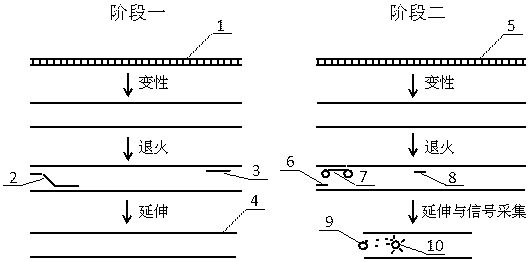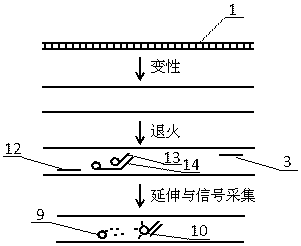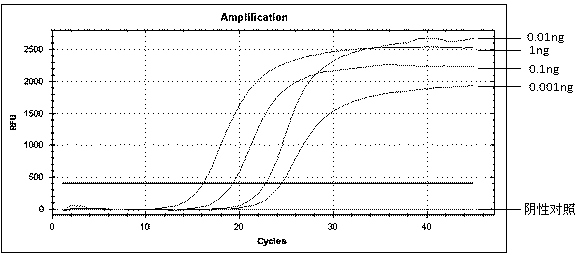Universal probe technology based fluorescent quantitation PCR (Polymerase Chain Reaction) method
A general-purpose probe, fluorescence quantitative technology, applied in the field of optimization of fluorescent probe technology, can solve the problems of high cost of Taqman probe synthesis and increase of experimental cost, etc.
- Summary
- Abstract
- Description
- Claims
- Application Information
AI Technical Summary
Problems solved by technology
Method used
Image
Examples
Embodiment 1
[0019] The polymorphic site rs671[A / G] of ALDH2 is detected by the fluorescent quantitative PCR method of the terminal universal probe. The fluorescent quantitative PCR reaction process based on the terminal universal probe used in this embodiment is as follows figure 1 As shown, the reaction is divided into two stages.
[0020] The first stage is ordinary PCR amplification for polymorphic sites. Primers are designed according to the template sequence 1. The sequences of the upstream combined specific primer 2 are divided into two types: wild type and mutant type. See Table 1. SEQ ID NO.1 and 2 , see the sequence of downstream specific primer 3 in Table 1. SEQ ID NO.3. 20μL reaction system, including TaKaRa Taq HS (5 U / μl) 0.2μL, 10×PCR Buffer 2μL, dNTP Mixture (each 2.5mM) 1μL, three kinds in the system The primers are mixed at a molar ratio of 1:1:2, and the final concentration of each primer is between 200 and 500nM. Three human genomes with known genotypes after generation...
Embodiment 2
[0024] Utilize the fluorescent quantitative PCR method of middle universal probe to detect the content of Escherichia coli nucleic acid, the fluorescent quantitative PCR reaction process based on middle universal probe used in this embodiment is as follows image 3shown. Primers were designed according to the specific sequence 1 of the Escherichia coli genome, the sequence of the upstream specific primer 12 is shown in Table 1 SEQ ID NO.8, the sequence of the downstream specific primer 3 is shown in Table 1 SEQ ID NO.9, and the sequence of the intermediate combination specific primer 14 is shown in Table 1 SEQ ID NO.10, the sequence of the middle universal probe 13 is shown in Table 1. SEQ ID NO.11. In the 20 μL reaction system, the four primers are mixed at a molar ratio of 2:2:1:1, and the final concentration of each primer is between 100 and 400 nM , the final template concentrations were 1ng / 20μL, 0.1ng / 20μL, 0.01ng / 20μL, 0.001ng / 20μL, and a tube of negative control was ad...
PUM
 Login to View More
Login to View More Abstract
Description
Claims
Application Information
 Login to View More
Login to View More - R&D
- Intellectual Property
- Life Sciences
- Materials
- Tech Scout
- Unparalleled Data Quality
- Higher Quality Content
- 60% Fewer Hallucinations
Browse by: Latest US Patents, China's latest patents, Technical Efficacy Thesaurus, Application Domain, Technology Topic, Popular Technical Reports.
© 2025 PatSnap. All rights reserved.Legal|Privacy policy|Modern Slavery Act Transparency Statement|Sitemap|About US| Contact US: help@patsnap.com



